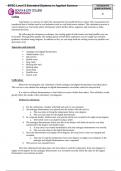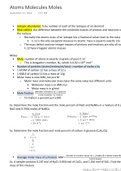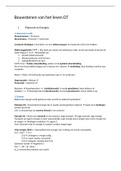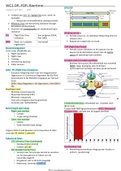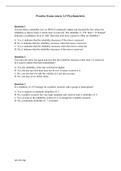L0 – introduction
Differences between machines and humans is for humans the ability to learn (exercisability).
Pavlov considered skill learning by neural paths that are created with stimulus-response pairing.
Bernstein;
- A repetition is never identical to a previous one. (DoF)
- Repetition is important to create movement solutions.
- Due to elasticity of muscles brain cannot know in advance effect of command
Chemero;
RT argues that;
- Perception & action explained by internal processes
- Mental representations connect organism and environment
- Perception & action represented in the mind/CNS
- Learning constructing new or adjusting present schemes/rules
ART argues that;
- No internal processes are needed
- Direct coupling between perception and action
- Perception and action coupled by interaction organism and environment
- Learning change relation between organism and environment
Computational theory;
- Explains how representations are used (like processing of symbols in computer).
Gibson;
- Perception is direct (no mental representations)
- Perception serves to guide action
- Information to guide action is available in environment (affordances)
Affordances; opportunities for action for a particular organism the environment particular offers. \
Dreyfus;
- Beginners use rules and expert do not
- Learning is about perceiving the world in a different way
- He came with ‘frame-problem; how does pc know what is not relevant?
- 5 stages of learning
RT cannot describe rules because stored in the brain and cannot be accessed by conscious.
ART cannot describe rules because it is about changing the relation between organism and
environment.
Fitts and Posner;
- 3 stages of skill learning
- RT because; learning is different. Subroutines of a program change in internal cognitive
processes
L1 – motor programming approach
Guidance mechanism for feedback in learning is about guide a learner’s actions with increasing
amount of feedback during learning. This improves action but does not improve learning because
learner becomes dependent. Feedback schedules are useful.
, KP and KR is info about errors.
Transitional information is about how to improve the errors.
Zimmerman self-regulation is degree in which individuals are motivationally and behaviorally active
in their own learning process. This improves performances and contribute to perception of self-
control which enhance learning through deeper information processing.
YOKE; matched to self-control group, this is done to see if it’s not due to amount or timing of fb but
about self-control.
Performance during practice not ideal for measuring learning because still with fb and instructions
and you don’t measure the relative permanent changes in performance. There for you need to
remove the fb, instructions etc.
Blocked practice; AAA-BBB-CCC etc.
Contextual interference; is learning one task during the performance of another task. It affects
learning in a positive way, performance is worse, but learning is enhanced. The higher the CI the
more you switch between tasks.
CI better for learning (Schmidt and Bjork 1992) because you need to find new solutions.
Summary feedback; fb after set of trails, this reduces performance but enhances learning.
Faded/fading fb; starting with high amount of fb and slowly decreasing the fb. Reduce performance
but enhances learning.
Differences between Adam & Schmidt
Adams specific rule for each movement.
Schmidt argues schemes of set of movements.
Schmidt’s schema theory;
Recall; movement production
- Input; KR, response specification of earlier movement
- Output; response specification of upcoming movement
- Stored info:
o initial conditions before movement
o parameters assigned to the GMP
o KR
Recognition: movement evaluation
- Output; expected sensory consequences for upcoming movement
- Stored info;
o Initial conditions before movement
o KR
o Sensory consequences
subjective reinforcement: perceptual trace suffices for learning to occur. Perceptual trace is enough
to let learning occur.
Generalized motor program; attention to a movement.
Differences between machines and humans is for humans the ability to learn (exercisability).
Pavlov considered skill learning by neural paths that are created with stimulus-response pairing.
Bernstein;
- A repetition is never identical to a previous one. (DoF)
- Repetition is important to create movement solutions.
- Due to elasticity of muscles brain cannot know in advance effect of command
Chemero;
RT argues that;
- Perception & action explained by internal processes
- Mental representations connect organism and environment
- Perception & action represented in the mind/CNS
- Learning constructing new or adjusting present schemes/rules
ART argues that;
- No internal processes are needed
- Direct coupling between perception and action
- Perception and action coupled by interaction organism and environment
- Learning change relation between organism and environment
Computational theory;
- Explains how representations are used (like processing of symbols in computer).
Gibson;
- Perception is direct (no mental representations)
- Perception serves to guide action
- Information to guide action is available in environment (affordances)
Affordances; opportunities for action for a particular organism the environment particular offers. \
Dreyfus;
- Beginners use rules and expert do not
- Learning is about perceiving the world in a different way
- He came with ‘frame-problem; how does pc know what is not relevant?
- 5 stages of learning
RT cannot describe rules because stored in the brain and cannot be accessed by conscious.
ART cannot describe rules because it is about changing the relation between organism and
environment.
Fitts and Posner;
- 3 stages of skill learning
- RT because; learning is different. Subroutines of a program change in internal cognitive
processes
L1 – motor programming approach
Guidance mechanism for feedback in learning is about guide a learner’s actions with increasing
amount of feedback during learning. This improves action but does not improve learning because
learner becomes dependent. Feedback schedules are useful.
, KP and KR is info about errors.
Transitional information is about how to improve the errors.
Zimmerman self-regulation is degree in which individuals are motivationally and behaviorally active
in their own learning process. This improves performances and contribute to perception of self-
control which enhance learning through deeper information processing.
YOKE; matched to self-control group, this is done to see if it’s not due to amount or timing of fb but
about self-control.
Performance during practice not ideal for measuring learning because still with fb and instructions
and you don’t measure the relative permanent changes in performance. There for you need to
remove the fb, instructions etc.
Blocked practice; AAA-BBB-CCC etc.
Contextual interference; is learning one task during the performance of another task. It affects
learning in a positive way, performance is worse, but learning is enhanced. The higher the CI the
more you switch between tasks.
CI better for learning (Schmidt and Bjork 1992) because you need to find new solutions.
Summary feedback; fb after set of trails, this reduces performance but enhances learning.
Faded/fading fb; starting with high amount of fb and slowly decreasing the fb. Reduce performance
but enhances learning.
Differences between Adam & Schmidt
Adams specific rule for each movement.
Schmidt argues schemes of set of movements.
Schmidt’s schema theory;
Recall; movement production
- Input; KR, response specification of earlier movement
- Output; response specification of upcoming movement
- Stored info:
o initial conditions before movement
o parameters assigned to the GMP
o KR
Recognition: movement evaluation
- Output; expected sensory consequences for upcoming movement
- Stored info;
o Initial conditions before movement
o KR
o Sensory consequences
subjective reinforcement: perceptual trace suffices for learning to occur. Perceptual trace is enough
to let learning occur.
Generalized motor program; attention to a movement.

